
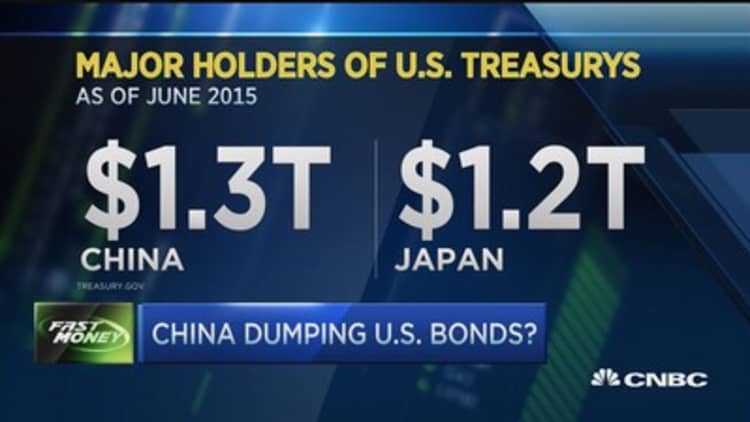
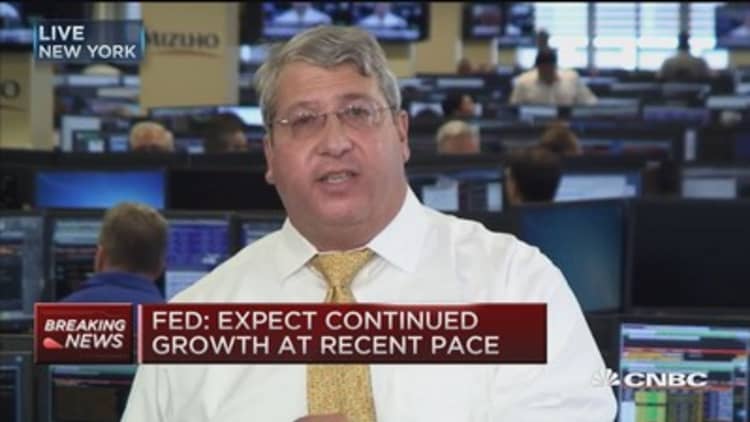
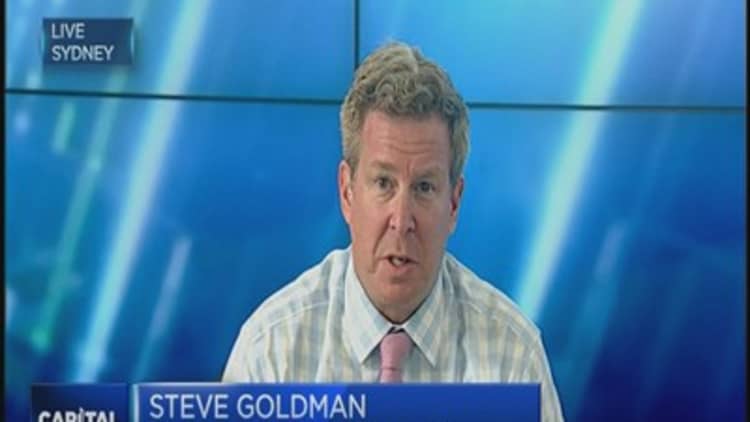
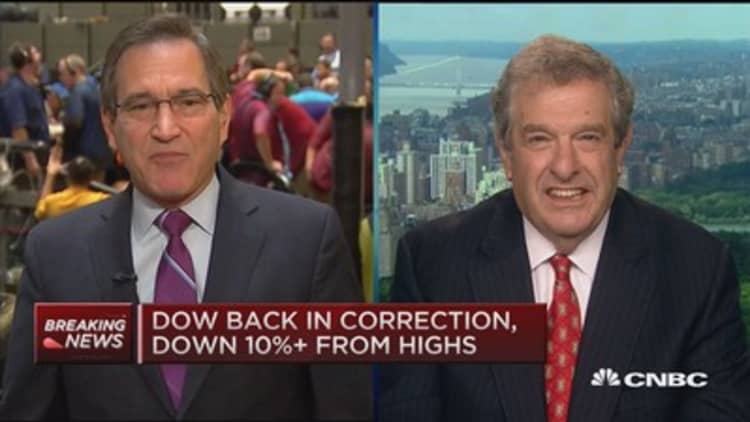
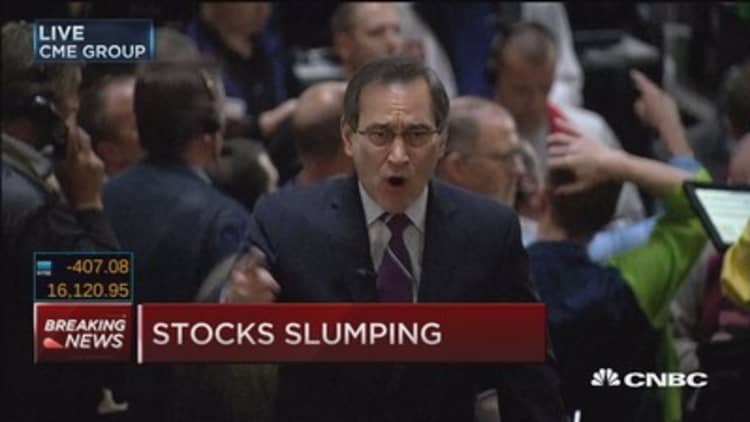
Wall Street may be torn about the direction of the global economy and when the Federal Reserve should raise benchmark interest rates, but bond traders appear to be bracing for an imminent move. (Tweet this.)
Short-dated Treasury debt yields, which are tied most closely to monetary policy forecasts, rose in August, with the yield logging its fifth straight monthly increase. That was its longest winning streak since 2006 when the Fed last raised interest rates.
Long-dated Treasury yields, often seen as a safe haven from stock market volatility, are virtually unchanged on the year, suggesting that bond investors are brushing off the panic about slowing global growth.
Read MoreJoachim Fels: Why US economy is torn right now
"As everyone tries to figure out what was said in Jackson Hole, I think the market is speaking that there is still a possibility that the Fed raises in September," said Peter Boockvar, chief market analyst at the Lindsey Group. "I think it's still 50/50, but when the two-year yield's back above 70 basis points that means that market participants have put it back on the table as a possibility."
Treasury yields gave back some gains this week as U.S. stocks tumbled after poor manufacturing data out of China and the U.S. spurred renewed worries of a global slowdown.
The yield drifted below 0.70 Thursday as stocks looked for some modest gains after a selloff earlier in the week.
Bond traders expect the market to remain volatile going into the August jobs report on Friday as it could be a key decider of whether the Fed moves off its near-zero level.
If the payrolls number is in line with expectations of an addition of 220,000 jobs, the Federal Open Market Committee could be more inclined to raise interest rates at the end of its Sept. 16-17 meeting. But that could be the last raise for a while, according to Boockvar.
If the FOMC raises, the rate will be "barely off of zero, but I think the ruckus that it's going to create could keep them on the sidelines for a while," he said. "I believe they're looking to raise, not because the data is telling them to raise, but because they have reached the end point of being at zero. … I think they've finally acknowledged that it's no longer appropriate."
Bond strategists said the recent path of the two-year yield, which has held steady this year, indicates that bond investors expect the Fed to raise rates once this year and once in the early part of 2016, but the trajectory is unclear after that.
Read MoreOnly the Fed can crash Wall Street
In comparison to stocks, many economists believe the bond market is a much better forecaster of economic growth and inflationary expectations.
The entire market is in a transition period, but "fixed income is really the place where you're kind of seeing it first or most globally," said Karissa McDonough, chief fixed income strategist at People's United Wealth Management, which manages $5.5 billion in assets.

There are growing signs of trouble in the high-yield market, as investors there have shifted to a risk-off sentiment, a sharp reversal from when the Fed was still injecting liquidity into the market. During that time, bond investors were willing to invest in the debt of high-risk companies because they had the luxury of knowing that the Fed's low rates would make debt burdens less onerous and help prevent companies from defaulting.
Bond strategists suspect that high-yield investors are concerned that liquidity will be less available when the Fed tightens, causing them to move their money first. Some say this sentiment could cause liquidity to dry up even faster and eventually force the central bank's hand to inject more liquidity down the line.
Read MoreOne of Wall St's biggest bulls throws in the towel
"If credit isn't available for the weakest borrowers, I don't know if that means a recession now, but there is a pretty tight historical correlation between the Fed tightening and default cycles," McDonough said. "It's usually about 18 months before you see a raise in defaults in the high-yield space after the Fed tightens. This could be kind of front running that because we have had several years now of easy money and this is a cycle that we have not seen before."
Market volatility started ahead of China, but the yuan devaluation was like "the straw that broke the camel's back," because it was a concrete piece of news that showed that there are stresses that policymakers are trying to respond to, McDonough said.
The devaluation and the surge of volatility in the equity market drew attention to the problems within the global growth story, but traders started to see cracking in the bond market as far back as June when the 10-year note yield dropped as much as 15 basis points, or 0.15 percentage points, in a day, according to McDonough.
The bond market had expected a certain level of global growth. There was a theme that the emerging markets were this engine of global growth, but China's recent devaluation of the yuan and the ongoing currency war shows some of the weakness of that story.
"Because so much money was flowing into those spaces, chasing high yields in the low-rate environment, those countries never needed to fix their governance structure, so they never had to reform," McDonough said.
Read MoreA key asset class most investors completely ignore
"Now, here we are in the face a tighter monetary cycle, globally, and all of a sudden they're facing lower commodity prices and currency strains. So this is where the cracks start. There's no real reform or fundamental growth drivers, which has kind of gutted the global growth story."
Wall Street has become largely divided on when the Fed should raise rates, with many investors forecasting that the current market turmoil could case the Fed to hold off for awhile. Market participants see a 27 percent chance that the Fed will hike in September, a 39 percent chance that it will hike in October and 58 percent chance that it will hike in December.
Some investors aren't convinced that the U.S. economy has strengthened enough for the Fed to lift rates, while others have said that the Fed would damage its credibility if it doesn't do so this year, citing the improving employment outlook.
"Any time they raise rates at a point and time when the economy is mediocre, they are taking a risk that their actions could hurt the economy even more. And, frankly, that will embarrass the Fed and hurt their credibility," said Bob Andres, founder and CIO of Andres Capital Management, which has more than $100 million in assets under management.
He doesn't believe the Fed is looking to raise rates for economic reasons.
"If they were doing it for economic reasons, we would see consistent growth of 3 percent or more" and an increase of inflationary expectations, which are going in the other direction now, Andres said.


